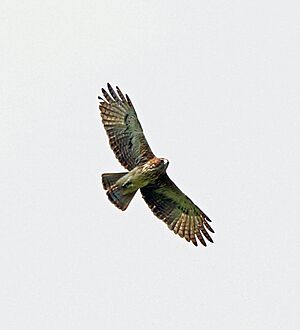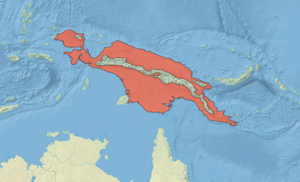Pygmy eagle facts for kids
The pygmy eagle or New Guinea hawk-eagle (Hieraaetus weiskei) is a small but mighty bird of prey. You can find it living in the forests of New Guinea. This amazing bird prefers to live in warm, wet forests, both in lowlands and on mountains. It's special because it's the smallest type of eagle in the world!
Quick facts for kids Pygmy eagle |
|
|---|---|
 |
|
| Conservation status | |
| Scientific classification | |
| Genus: |
Hieraaetus
|
| Species: |
weiskei
|
 |
|
| Synonyms | |
|
Hieraaetus morphnoides weiskei |
|
Contents
How Scientists Study the Pygmy Eagle
Scientists have a special way to name and group living things. This is called taxonomy. The pygmy eagle was first described by a German scientist named Anton Reichenow in 1900. He gave it the name Eutolmaetus weiskei.
For a while, some scientists thought it was just a type of little eagle. Others believed it was its own unique species. Later, scientists like Gjershaug and his team studied its genetics. They found that the pygmy eagle was different enough to be its own species. Because of this, the International Ornithologists' Union (IOC) officially recognized it as a separate species. They also made "Pygmy eagle" its official common name.
What the Pygmy Eagle Looks Like
Size of the Pygmy Eagle
The pygmy eagle is one of the tiniest eagles known in the world. It's also the smallest living member of a group of eagles called Aquilinae. Only the Great Nicobar serpent eagle is similar in its small size among modern eagles.
Pygmy eagles are about 38 to 48 centimeters (15 to 19 inches) long. Their wings can spread out from 112 to 126 centimeters (44 to 50 inches) wide. Female eagles are usually a little bigger than males. One male pygmy eagle was found to weigh about 483 grams (1.06 pounds). Studies suggest males typically weigh around 406 grams (0.89 pounds), while females weigh about 555 grams (1.22 pounds).
How to Identify a Pygmy Eagle
The pygmy eagle looks a lot like the little eagle. However, there are some key differences in their colors. The pygmy eagle has darker, more noticeable stripes on its neck, head, and belly.
It also shares features with the booted eagle. Both eagles have a special pattern under their wings. The feathers, or plumage, of the pygmy eagle can look different depending on its "morph." A morph is a color variation. There are light and dark morphs. The dark morph looks very much like the dark morph of the little eagle. The light morph shows the most differences, especially in its dark streaking. The dark morph seems to be quite rare. Most sightings (10 out of 11) have been of the light morph. The eagle's feet are described as grey or a dull yellow color.
The Voice of the Pygmy Eagle
When pygmy eagles fly, their call sounds like "sip sip yeeee." Their calls are similar to those of the little eagle and the booted eagle. Sometimes, they have also been heard making a softer, single-tone squeal.
Where Pygmy Eagles Live and Their Homes
Pygmy eagles mostly live in lowland forests and at the edges of forests in New Guinea. They like to build their nests in dense forests. However, they have also been seen in more open areas and at the edges of forests.
These birds seem to be spread out thinly across the hilly forests of New Guinea. But because many parts of New Guinea's forests are hard to reach, there might be more eagles than we realize. One very dense forest area in New Guinea is called Vogelkop, or Bird's Head Peninsula. Pygmy eagles have been seen there nineteen times over three years. They have also been spotted on the island of Buru and in the northern Moluccas.
What Pygmy Eagles Eat
Pygmy eagles are skilled hunters. They have been seen flying high and then diving down quickly to catch their prey in the forest treetops. These raptors can make very fast dives. They often attack other birds, such as the brown cuckoo-dove and the mountain fruit-dove. Usually, the eagle flies low over the forest canopy, looking for food. Once it spots a bird, it dives down to catch it.


